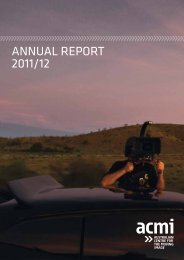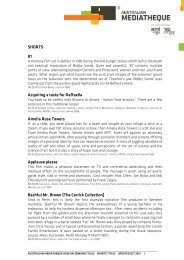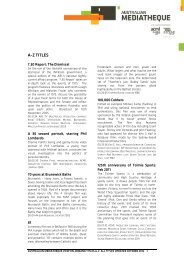Tim Burton's Gothic Imagination
Tim Burton's Gothic Imagination
Tim Burton's Gothic Imagination
You also want an ePaper? Increase the reach of your titles
YUMPU automatically turns print PDFs into web optimized ePapers that Google loves.
THE GOTHIC TRADITION AND FILM<br />
The initial thrilling attraction of <strong>Gothic</strong> architecture and literature was connected to the<br />
challenge it held out to the classicism and rationality of the Enlightenment perspective, but<br />
this way of representing the world has a continuing fascination. In the nineteenth century,<br />
<strong>Gothic</strong> fiction gave expression to excesses, perversities and passions that resisted the<br />
repressive practices of this period:<br />
Victorian popular fiction aimed to horrify readers by scraping the opaque surface of<br />
every day reality and foregrounding the deceptiveness of appearances. – Laurence<br />
Talairach-Vielmas 11<br />
American writer Edgar Allan Poe made a distinctive contribution to nineteenth century<br />
<strong>Gothic</strong> fiction, 12 while George W.M. Reynolds’ <strong>Gothic</strong> novels were hugely popular in Britain. At<br />
the end of the nineteenth century, a flurry of books like The Strange Case of Dr Jekyll and Mr<br />
Hyde (Robert Louis Stevenson, 1886), The Picture of Dorian Gray (Oscar Wilde, 1891) and<br />
Dracula (Bram Stoker, 1897) explored what lies both beneath and at the edge of rational<br />
human experience and existence.<br />
At the beginning of the twentieth century, the emerging feature film industry sought out<br />
stories that would capture the imaginations of early film audiences and relished the<br />
heightened emotional impact of the dark themes explored in <strong>Gothic</strong> literature. The act of<br />
going into a darkened cinema and entering the imaginary world created in a film has been<br />
likened to dreaming, so it is not surprising that filmmakers were eager to explore the strange<br />
and the unknown. Most of the visual language, thematic preoccupations and modes of<br />
characterisation still associated with the horror genre were set in train during the<br />
development period of the film industry.<br />
In particular, German filmmakers, inspired by the Expressionist movement in art, 13 developed<br />
a repertoire of techniques to explore and represent the dark themes integral to <strong>Gothic</strong> horror.<br />
Expressionist filmmakers seek to represent moods and emotions in the way they stage a<br />
particular scene (in what is called the mise-en-scène). Stylised sets and the use of light and<br />
dark (chiaroscuro) to create shadows were key features of this mode of filmmaking and<br />
underpinned a number of <strong>Gothic</strong>-inspired horror films such as Das Kabinett des Doktor<br />
Caligari (The Cabinet of Dr Caligari 1920, Robert Wiene) Nosferatu (1922 F.W. Murnau) and<br />
Der Golem, wie er in die Welt kam (1920, Paul Wegener).<br />
Hollywood-produced horror films drew readily on the literary heritage of <strong>Gothic</strong> fiction, as<br />
well as being inspired by the dark shadow worlds created in the German Expressionist films<br />
of the 1920s. They used a number of the visual conventions associated with these films but<br />
also reconnected with the ornate and the grotesque settings integral to the <strong>Gothic</strong> literary<br />
sensibility – partly due to increased financial resources. Whereas German Expressionist<br />
horror films tended to favour more abstract settings, Hollywood filmmakers often used fairly<br />
detailed sets imbued with claustrophobic terror. Dracula (Tod Browning, 1931) used striking<br />
Expressionist-inspired chiaroscuro effects and experimented with camera shots and<br />
dissolves. However, Browning substituted a more theatrical and attractive Dracula (played by<br />
Bela Lugosi) in the place of the starkly hideous Nosferatu. Although few twenty-first century<br />
FREE FOR EDUCATION Education Resources <strong>Tim</strong> Burton’s <strong>Gothic</strong> <strong>Imagination</strong> 7










